
|
The world of non-commercial film and A-V |
Events Diary | Search | ||
| The Film and Video Institute | | ||||
The making of Elegia
Elegia - The making of a Thomas Martin Double BassElegia won the 2004 Prix L’affiche du Monde - a contest to encourage films about major contemporary issues affecting the planet. The theme that is given "top billing worldwide" and which tomorrow's audiovisual creators set out to illustrate is common to all nations. That year’s theme was ‘mutations and metamorphoses’.
‘Elegia’ was filmed during the summer of 2002, but the story really began some 20 years earlier. At that time I was doing a sound recording of an orchestral arrangement of Bizet’s ‘Carmen’ scored for the London City Ballet by its musical director Leonard Salzedo. This was to be a new production and we were all invited to the final dress rehearsal before the ballet company went on tour. Our five year old daughter Kate came wih us and was entranced not only by the ballet, but by all the other activities happening on and around the stage. Like many girls of that age she wanted to be ballet dancer, but was disappointed when the choreographer said that he thought she would be too tall. Years passed and Kate was asked at school if she would like to learn play the double bass as the double bass player was leaving and Kate was considered the most suitable person to take over because of her height. This was to lead to her studying Bass at Birmingham Conservatoire. We learned later that it was the visit to the ballet all those years earlier that had made her want to study music and become a professional musician. After Birmingham, Kate went to study further at the Guildhall School of Music and Drama in London, her tutor there being Thomas Martin. Shortly after starting her career, Kate felt that she needed a better instrument and decided to have one made by her former teacher. ‘Elegia’ is the record of that bass being made in Thomas’ Oxfordshire workshop.
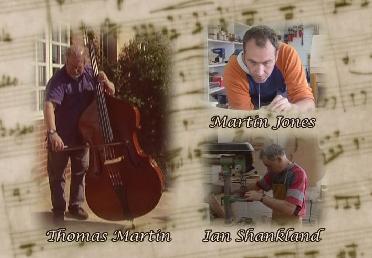
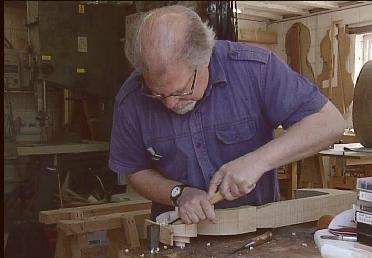
The making of the bass took some six weeks and I tried to be at the workshops to record the major stages in its construction. Of course, the three craftsmen were not working soley on Kate’s new instrument all the time, others were being made as well. With all this work going on, it meant that space was somewhat limited and I decided that adding lighting would compromise safety. This meant that I had to live with both fluorescent and varying natural lighting. Quite often the weather was typical of an English summer, dull and grey, but sometimes there was beautiful sunshine with cloudless skies. This all meant that there had to be quite a lot of colour correction in the final edit. Following colour correction for the differences in white balance I decided to slightly ‘brown up’ the overall image; this was an attempt to enhance the visual image to create the kind of atmosphere of the workshop that I felt when I was there.
My original intention had been to produce a longer documentary with commentary by Thomas and his collegues. Once I started editing I felt that the visuals said everything, well almost, and that a more artistic and atmospheric result would be achieved simply by editing to music with no spoken word or location sound to intrude.
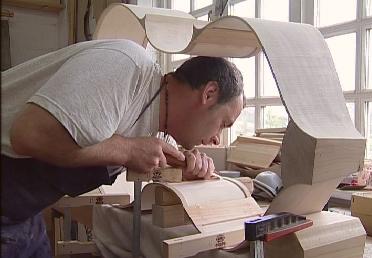
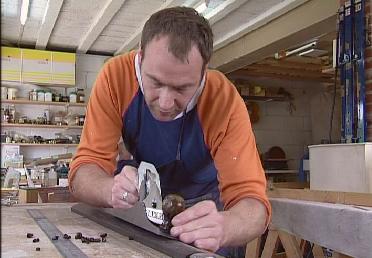
There are relatively few virtuoso works for solo bass and string orchestra, but ‘Elegia’, composed by Giovanni Bottesini (1821-1889), is one such work. I was fortunate in so far as Thomas had recorded the work some years earlier, but it had never been edited or released; Thomas lent me the original masters and I was able to edit these to produce the sound track for the video. Thomas has been principle bass player with many of the world’s leading orchestras so I was very fortunate to have his co-operation in making this video.
The video was shot using a Sony DSR130 DVCam and edited using Edius (then Version 1.0), it was the first occasion that I had used this software. The sound track was edited and processed using Wavelab.
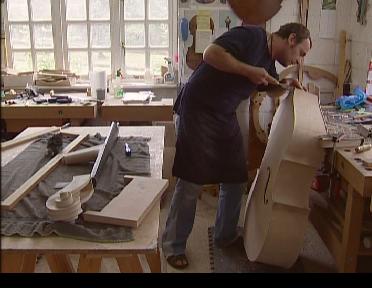
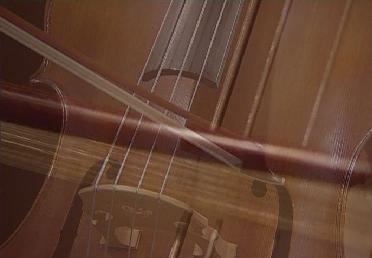
A couple of facts about the bass that might interest:
The front of the instrument is made from spruce and everything else, with the exception of the ebony fingerboard, is made from maplel; all of the woods had be felled at least eight years earlier.
The thickness of the sides of the bass is less than a millimetre thicker than that of a violin.
Professional players who have heard this instrument say that they think it to be the best that Tom has made – perhaps the presence of a video camera had something to do with this. Kate is very happy with the sound and I’m more than surprised with the success of my first competitive video.
Finally, a rather interesting fact, the first time Kate played her new bass was at a concert at which, quite unknown to her, Leonard Salzedo’s widow was the guest of honour at the premiere performance of a work composed by her late husband. It seemed that the clock had turned full circle!
- Geoff Addis August 2004
Elegia was one of the UK offical entries to UNICA 2004, Germany.
Click here to read more about UNICA 2004
and other UK entries.
Share your passions.

Share your stories.